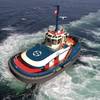Data Processes 4x Faster: How Ulstein Does It
How do you excel at ship design? Bart Daman, Manager Naval Architecture at Ulstein Design & Solutions BV in Rotterdam, has an answer: "In our case, by combining specialist knowledge and expertise focused on certain niche markets with data-driven work. This allows us to quickly develop new high-quality ship designs. Our customers experience the difference, and we often hear that they are impressed by the quality of the information we provide. From quotations to full construction specifications, all our information is correct."
How did Ulstein achieve this significant efficiency gain, and what benefits do they experience from data-driven working?
Bespoke ship designs in the blink of an eye
Ulstein's Rotterdam office specializes in designing offshore installation vessels, which are often highly complex and one-off projects. Each new ship design brings new challenges. "Of course, we feel like fish in water when it comes to large, complex ship designs," Daman said, pointing to the unique design of the Alfa Lift 1 vessel for Seaway 7 (formerly Offshore Heavy Transport - OHT).
"Now that we are working data-driven, we can get to work even faster than before with the knowledge we already have in-house. It also allows us to start more quickly on complex, new challenges in a project. In the past, when we worked mostly with individual files like any other designer, project preparation was much more labor-intensive and more sensitive to error," Daman said.
Complex, new ship designs are better off with smart processes
"Let me give an example. When working with Word and Excel, information is often copied from existing files of previous projects, which is then modified for a new project. However, with this, any errors from other files are also copied with it. In addition, different versions of the same document may arise during a project, because they are not centrally stored. Then the question is, who has the correct version? This is obviously undesirable and can be done much smarter."
Working data-driven: peace of mind, higher level of knowledge and transparency
Daman said, "Sometimes working data-driven sounds somewhat complicated, but we have been working with Shipbuilder Software for years, and it has provided us a lot of peace of mind and convenience in the organization. We store all our design knowledge in Shipbuilder Software. A continuous process in which our most recent acquired insights in ship and system design are stored invariably. Everyone in the organization can thus access the information relevant to that person in his/her project. Each new project is based on the latest knowledge, to which project-specific data is added. As a result, our shared knowledge level is increasing faster and faster. Checking standard data for each project is hardly necessary anymore, as we have already done this during the initial input. All in all, this results in considerable time savings and a very consistent design package."
"We have become much more transparent as well," Daman continued, "both in-house and towards our customers. The entire process of reviewing, commenting and approving of drawings/documents by the customer runs via Shipbuilder Software. For example, clients can now see in real-time the status of a change they requested. So, one does not have to look up an Excel file or drawing in Outlook, but can immediately see our response to a proposed change. This creates a transparent log, and customers are very pleased with this."
Working data-driven fits professional ship design
According to Daman, working in a data-driven way also has commercial benefits. "We are now much faster during the tender phase and can start a new project four times faster." For example, Daman cited the development of technical specifications: "For any project, we have them ready within a few days. Typically it used to take up to two weeks or sometimes even longer. A huge advantage for our customers. This way of working suits our professional approach, where the customer gets a design of unprecedented high quality."
Future
Ulstein, in association with Shipbuilder, the company behind Shipbuilder Software, will continue to focus on implementing the concept of data-driven working even further in the coming years. Daman said, "Hours and budgeting are increasingly integrated and stored centrally as knowledge, which allows us to be even more conscientious during a tender phase. For each new design project, we develop our product and activity overviews centralized in Shipbuilder, making the design process transparent and more manageable for everyone. Not only does this allow our customers to get started faster with the construction of our design, but they can also use it as the basis for consistent document management throughout the life of the ship."









